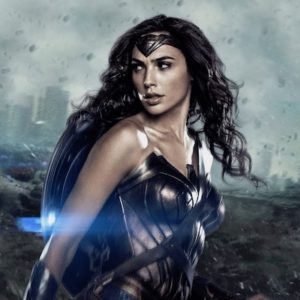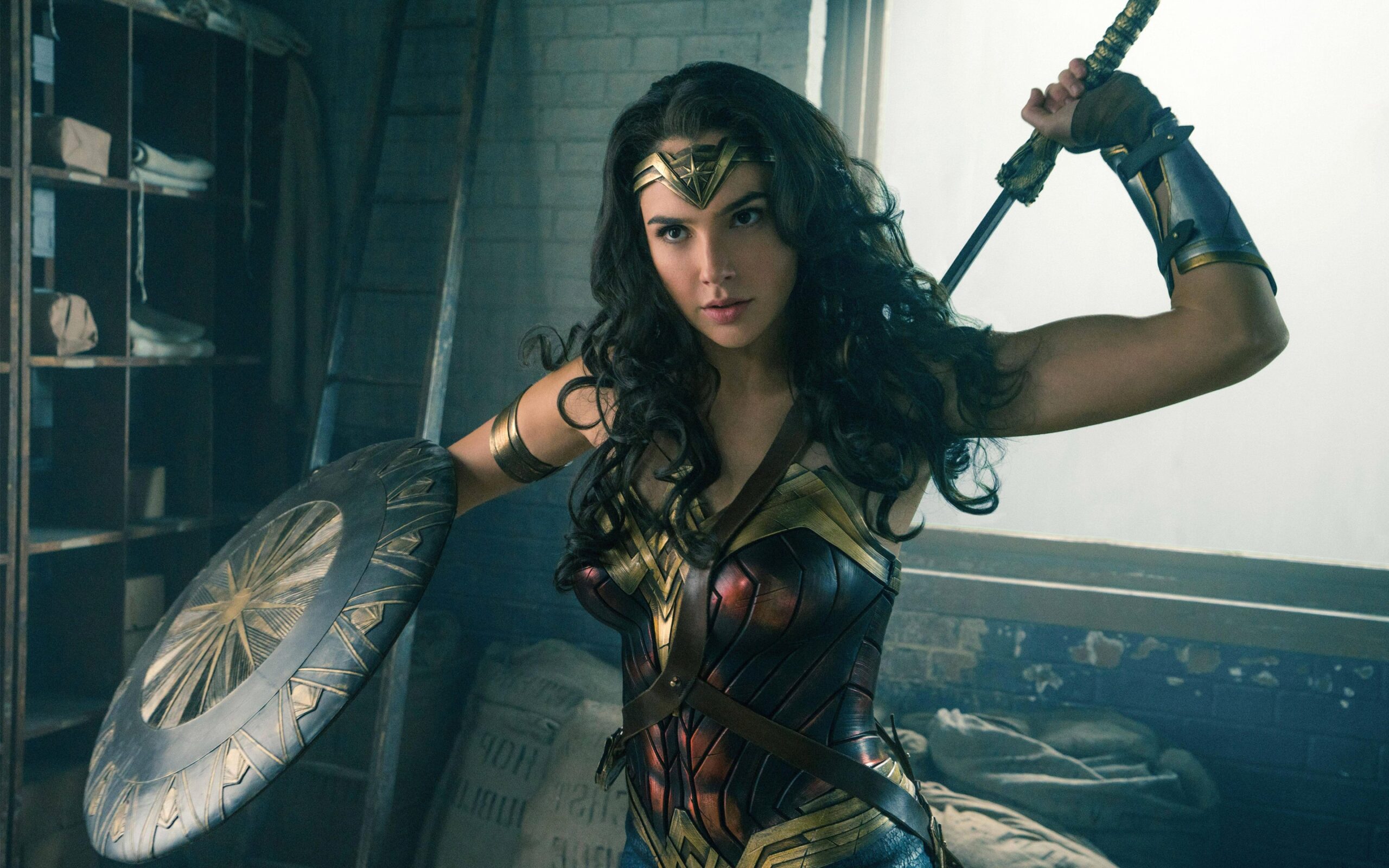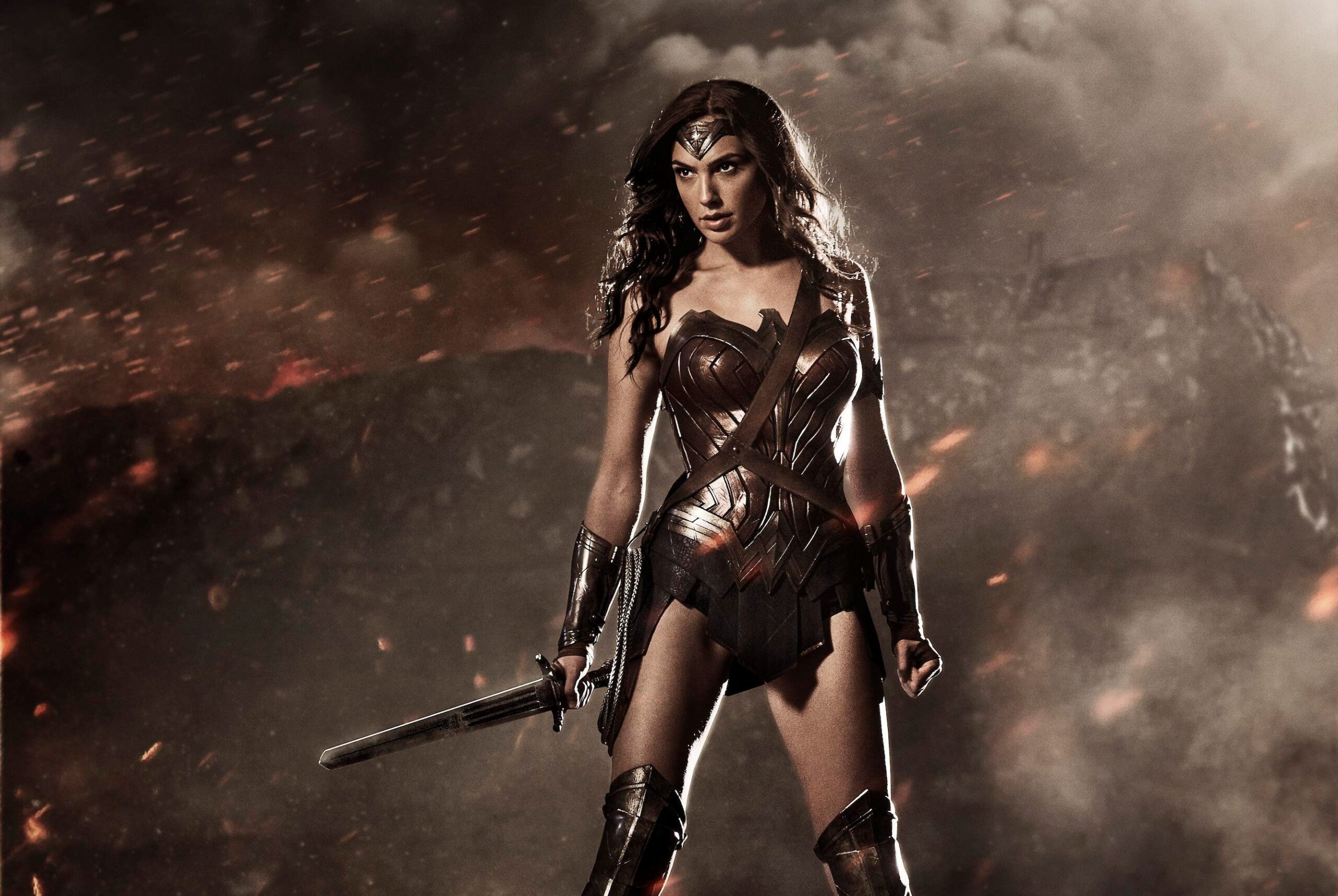
Moments before climbing out of an Allied trench on the Western Front to face German firepower, Wonder Woman, played by Gal Gadot, pauses for an unusual step in preparation: she lets her hair down. It’s a curious moment to watch, especially for a long-haired brunette like myself. I put my hair up before any moment of anticipated knotty chaos: a long run, a drive with the windows down, a windy day, gardening, home repairs. For superheroes, however, long hair could be considered as hazardous as the capes against which Edna Mode warned so strictly in The Incredibles: it could catch on things, obstruct vision, and generally put a superhero at risk. One might worry that unleashing a mane of dark hair just before going into battle could really backfire.
But, by this point in the film, it’s clear that the metaphor of “letting one’s hair down”—relaxing, getting comfortable, letting it all go wild—is more fitting to Wonder Woman facing battle. What the viewer perceives as a moment pure peril is, to a demigoddess like Diana, Princess of Themyscira, Daughter of Hippolyta, an arena of unhindered and unflinchingly confident self-expression. The battlefield is her wheelhouse. It’s her comfort zone. She’s not just letting her hair down; she’s letting her flag unfurl.
Men who make superhero movies do not understand when it would make sense to tie your hair back. Witness Black Widow’s tangle in Iron Man 2. And yet, Patty Jenkins, who directed this superhero movie, has Wonder Woman let her hair down on purpose.
It’s a moment only a female director could embrace so carefully. And this supreme, feminine confidence is what makes Wonder Woman so thrilling to watch, at least for the female viewer, if not for everyone: Diana has been raised to embody her full, fearless potential, and is dedicated to her own mission without regard for, and without knowledge of, a gender hierarchy, or the notion that anything should stand in her way. The only tragedy is that, in 2017, we’ve never seen a character like this before.
*
I watched the film on a Saturday afternoon with three fourteen-year-old boys. Did they get it? No. But I understood this was a new experience for them: for the first time, we were seeing a film for which they were not the primary audience.
Did I tell them that I was holding back tears through most of the film—from the first scenes of Diana’s empowered childhood, to the moment she leaves her overly cautious mother behind, to her empathy for the wounded soldiers returning from war, to her unleashing her hair and emerging from the trench? I did. But, look, it’s hard to explain to the average—excuse me, above average—white male how refreshing and empowering it is to witness a woman who has not been cultured or indoctrinated to believe she is subordinate to anything or anyone.
Women I know who saw the film echoed my feelings. My cousin Nora McNamara, a child psychiatrist in Cleveland, messaged me, “I was actually crying through like 90 percent of it, because I was so happy to finally get one for us. Like I would have been crying on HRC’s inauguration.” Another friend, author Marissa Korbel, wrote:
Why have I never seen women like this? Why is this just something I’ve had to whisper to myself as a possibility? …I just regret that I really never felt like that archetype was made available to me as a young girl. …ALSO: I got up this morning and was like: I need to go to the gym and throw boulders. IMMEDIATELY.
*
I drink my coffee every morning from a mug that shows Wonder Woman rendered by different artists over each decade since the 1940s. Across eighty years, Wonder Woman never ages, but her soft facial features take on an edge, her muscles grow more defined, and her bust increases while her outfit shrinks. More than anything, however, her shadows sharpen.
Most of the artists who have drawn Wonder Woman were men, except for Trina Roberts and Nicola Scott. And, to be sure, the character of Wonder Woman did not emerge from the mind of a woman. She burst, fully formed, from the brain of Harvard-trained psychologist, William Moulton Marston, and was drawn onto the pages of DC Comics by artist Harry G. Peter, in 1941.
The suffragists and feminists of Marston’s early adulthood, including his wife, Elizabeth Holloway Marston—also a psychologist, though trained at Radcliffe because Harvard did not admit women—were his primary inspirations. Those influences included the couple’s live-in partner and mother to two of Marston’s children, Olive Byrne, who has been credited as the main inspiration for Wonder Woman. Byrne was the niece of Margaret Sanger, the legendary pioneer of birth control and Planned Parenthood, who devoted her life to reproductive freedom for women. All of these women and their stories inspired Marston, but it was he who crafted them into character. (Marston also invented the lie detector machine, hence Diana’s lasso of truth.)
The 2017 Wonder Woman, brilliantly directed by Patty Jenkins—whose touch, as a woman, defines this film—is also the brainchild of men: Allan Heinberg wrote the screenplay based on the story he wrote with Zack Snyder and Jason Fuchs. I’m not the least bit discouraged to know that men are behind this project; on the contrary, I’d like to see more of anyone inventing and writing female characters, with or without superpowers, who play a decisive role in the fate of our world. But let’s also see men who view a woman’s strength and potential as more than a fetish.
It’s grating, for example, when the otherwise charming mercenary soldier, Sameer, calls Diana a “work of art”—literally an object. A few minutes later, when he sees her topple an adversary in a bar, he comments, “I am both frightened and aroused.” Marston himself, when he first created Wonder Woman, deployed her as a vehicle for his interest in bondage, submission, and free love, and also for his belief that women deserved equal rights and autonomy—that they could, in short, rescue themselves. That tender balance can be misconstrued as pure objectification. To the feral eye, a woman in full command of her body may look like a an invitation. But as Marston knew, women deserve sexual and reproductive autonomy for themselves, not to be amplified as sexual objects.
For most women I’ve talked to, and for myself, one of the most invigorating characteristics of this latest incarnation of the demigoddess Diana is her ignorance of the patriarchy. She’s unthwarted by the idea that there are situation rooms into which her sex is not permitted, and under no impression that, once in the room, she is anything but a worthy peer to everyone present.
Despite her exhaustive education and ability to speak hundreds of languages, the script believably plays up Diana’s naiveté after her arrival in London. Captain Steve Trevor, who has promised to guide Diana to “the war,” has to move her aside so she doesn’t get hit by an oncoming car, and shield her from the catcalls of nearby men, of whom she is oblivious. Of a passing couple, she asks Trevor, “Why are they holding hands?” “What do these women wear into battle?” she asks when Trevor tells her she has to cover her bare skin. In a department store, she regards a corset on a mannequin and asks, “Is this what passes for armor in your country?” Soon, he will tell her what snow is.
In this way, Diana is reminiscent of Emma “Billie” Dawn in the 1950 film Born Yesterday. Billie is the quintessential dumb blonde who, underestimated, turns out to be smarter than anyone had imagined and powerful enough to weed out corruption among certain politicians in Washington, DC. Ultimately, these men’s ignorance of Billie’s potential is their undoing. Similarly, in Wonder Woman, Diana’s blindness to Western culture ensures she is unhindered by it. And her magnificent naiveté about the patriarchy is delicious to watch, because it’s an ignorance many of us wish we had.
Nevertheless, Steve Trevor, the self-proclaimed “above-average” male of the species whom Diana plucks out of the ocean from his sinking airplane when he crash-lands near her island, becomes both her love interest as well as her human speed bump. At every turn, he suggests that his mission should take priority, that his agenda supersedes hers, that she should not stop to help people in need, nor climb out of the trench into the No Man’s Land of the Western Front, nor proceed fearlessly into the German High Command. She looks at him with a furrowed brow. If there was ever a case for women avoiding Botox, Diana’s signature skepticism for the patriarchy is it. She has never encountered womanhood as subordinate, and she’s not about to start.
*
I grew up in a house full of women. My mother’s career as a private pilot rivaled my father’s as an airline captain. Among my three older sisters, I often felt like there was nothing a girl couldn’t do. I watched their lives, learned their lessons, and lived through their encouragement. Each of them, at one time or another, and like most women I know, embodied their own private versions of Diana facing down fire on the Western Front. My sisters taught me what it meant to be a strong woman. The female paradise of my childhood was no fog-cloaked Themyscira; it was just suburban Philly. And, like Diana’s time on her Amazonian island, it wouldn’t last.
Growing up in the 70s, my sisters and I watched Lynda Carter as Wonder Woman every week on television. We also watched The Bionic Woman, reruns of Bewitched, and every other show about modern women doing whatever they had to do to stay in step—or a step ahead—of the men around them. Mary Tyler Moore in The Mary Tyler Moore Show, Valerie Harper as Rhoda, Marlo Thomas as That Girl, and Beatrice Arthur as Maude. Less so Charlie’s Angels because, although they were super cool, they were directed not only by a male manager but by the voice of a disembodied male overlord.
Since then, iterations and modifications of Wonder Woman have been continuous, and they’ve marked our evolution as women. Today’s Wonder Woman seems to possess the perfect mix of empathy and fortitude for these uncertain times, when our country under Trump’s leadership feels more unstable than ever. Yet, Diana is neither American nor fighting specifically for American goals; this superhero movie shifts the center of action and allegiance away from America entirely. Diana of 2017 is a warrior against war itself, whose nemesis pretends to promote peace as an underhanded way to maintain endless war. Still, I’m sure I wasn’t the only woman watching this film who felt that Wonder Woman was the entire Women’s March balled up into a single character and hurled at the worst leader of our generation, if not in our country’s history. We’re all Diana, climbing out of the trenches into the devastated landscape, facing opponents both hidden and in plain sight.
Playing Diana’s fierce warrior trainer and mentor, General Antiope, Robin Wright marks an evolution of her own. Wright was once a princess, too: the beautiful, benign “Buttercup” in The Princess Bride (1987). Sure, she was in Forrest Gump, and she was Sean Penn’s best wife, and she starred in a string of unremarkable roles until she burst back onto the map as the ruthless Claire Underwood in House of Cards. Claire is willing to sacrifice anything to capture power in America’s capital—only in the opposite way Billie challenges power in Born Yesterday. It’s because of her role as Claire Underwood that Wright is so believable as Antiope. The scars on her shoulder transcend makeup: we know Robin Wright has seen some shit, and she’s not just training Diana; she’s training all of us. “You are stronger than you know,” she tells Diana. “You have greater powers than you know. But if you don’t try harder…”
Even the evil female in Wonder Woman gets her empowerment. Doctor Poison—also a former DC Comics princess, Maru, and a creation of Marston—is working to develop a deadly gas that will win the war for Germany. When she doubts her progress, General Ludendorff assures her, “I know that you can and will succeed. It was what you were put on this earth to do.” Later, an undercover Trevor attempts to seduce her in the same fashion, telling her he is, “a man who would show a genius like yourself the appreciation she deserves.” Oh, what we might all become, ladies, if the men in our lives spoke to us like this on the daily.
Despite being trained for battle from childhood and equipped with powers to face the most formidable opponent, Diana still does not realize her own potential until she’s met with the opportunity to face her nemesis—her own godly brother—face to face in the world of men. He taunts her with doubt, but each word is also a challenge to bring out her best: “Let’s see what kind of god you are.”
How can any woman watching this film not hear those words as the challenge of our times? It’s not just Diana’s physical prowess that inspires—though the fight scenes are as thrilling and graceful as dance—it’s her character. Diana outmatches her opponent not because she knows exactly how she’ll do it, or even who precisely her opponent is, but because there is no other way. So, ladies, let your hair down, pin it up, or do whatever makes you feel free, and let’s show them what kind of gods we are.
***
Image credits: feature image, image 1, image 2.






